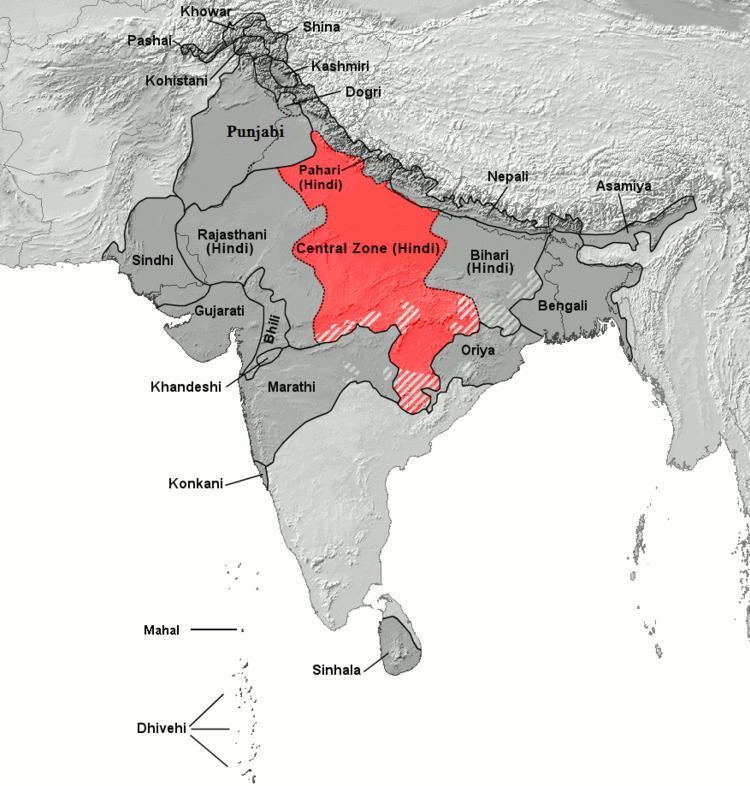Geographic
distribution: South Asia | ||
 | ||
Linguistic classification: Indo-European
Indo-Iranian
Indo-Aryan
Hindi
(Central Zone) Subdivisions: Western Hindi
Eastern Hindi Glottolog: None
west2812 (Western Hindi)
east2726 (Eastern Hindi) | ||
The Central Zone or Madhya languages are the central varieties of the Hindi Belt, spoken across northern India, of the Indo-Aryan languages. It is a dialect continuum that descends from the Madhya Prakrits. The Western Hindi languages include Hindustani, of which Modern Standard Hindi and Urdu, are mutually intelligible standardizations of the Khariboli dialect, the prestige dialect of Hindustani. The coherence of this group depends on the classification being used; here only Eastern and Western Hindi will be considered.
Contents
Languages
If there can be considered a consensus within the dialectology of Hindi proper, it is that it can be split into two sets of dialects: Western and Eastern Hindi. Western Hindi evolved from the Apabhramsa form of Shauraseni Prakrit, Eastern Hindi from Ardhamagadhi.
- Western Hindi
- Braj Bhasha(570T), spoken in western Uttar Pradesh and adjacent districts of Rajasthan and Haryana
- Haryanvi(8M), spoken in the states of Haryana and Delhi.
- Bundeli(3M), spoken in south-western Uttar Pradesh and west-central Madhya Pradesh.
- Kannauji(9.5M), spoken in west-central Uttar Pradesh.
- Hindustani(312M), including the standard vernacular dialect Khariboli (and its standardised forms Standard Hindi and Urdu), spoken in western Uttar Pradesh and Delhi.
- Eastern Hindi
- Awadhi(3M), spoken in north and north-central Uttar Pradesh as well as Fiji.
- Bagheli(8M), spoken in north-central Madhya Pradesh and south-eastern Uttar Pradesh.
- Bihari Hindi, spoken in Bihar and Jharkhand
- Chhattisgarhi(13M), spoken in southeast Madhya Pradesh and northern and central Chhattisgarh.
- Bhojpuri(48M), spoken in eastern Uttar Pradesh, western Bihar, northwestern Jharkhand, the northeastern part of Madhya Pradesh, and in the northern part of Chhattisgarh, it is also spoken in Madhesh, Nepal. It is also spoken by the Bhojpuri diaspora in Pakistan, Bangladesh, Trinidad and Tobago, Guyana, Suriname, Jamaica, other parts of the Caribbean, Fiji, Mauritius, and South Africa.
- Magahi(14M), spoken in south-east Bihar and Jharkhand.
Romani, Domari, Lomavren, and Seb Seliyer (or at least their ancestors) appear to be Central Zone languages that migrated to the Middle East and Europe ca. 500–1000 CE in three distinct waves. Parya is a Central Zone language of Central Asia.
To Western Hindi Ethnologue adds Sansi, Powari, Chamari (a spurious language), Bhaya, Gowli (not a separate language), and Ghera.
This analysis excludes varieties sometimes claimed for Hindi for cultural reasons, such as Bihari, Rajasthani, and Pahari.
Use in culturally non-Hindi regions
Comparison
The standard educated Delhi Hindustani pronunciations [ɛː, ɔː] commonly have diphthongal realizations, ranging from [əɪ] to [ɑɪ] and from [əu] to [ɑu], respectively, in Eastern Hindi varieties and many non-standard Western varieties. There are also vowel clusters /əiː/ and /əuː/.
